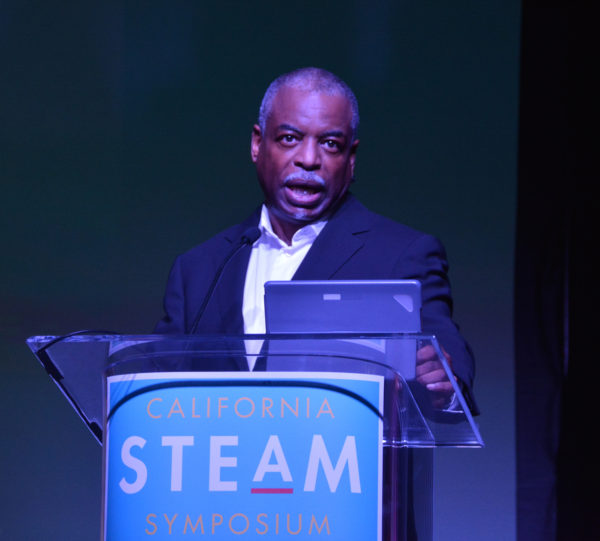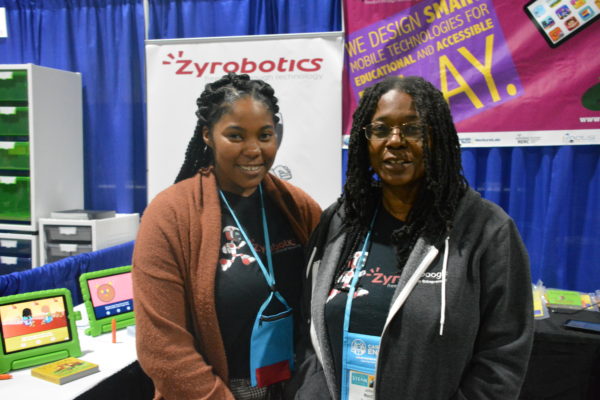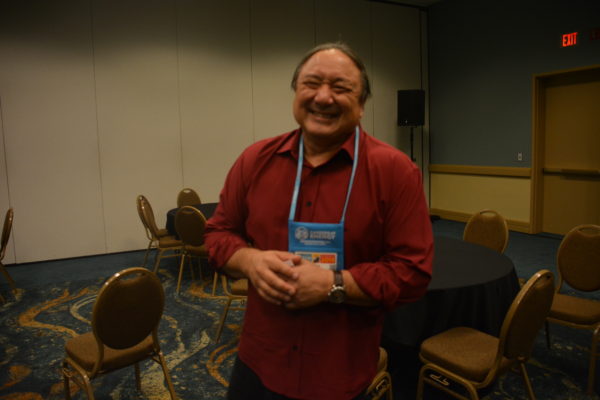By Dot Cannon
“I believe that literacy is the birthright of every single one of us,” said LeVar Burton. “No exceptions.”
The capacity-crowd audience applauded.
Day Two of the 2018 California STEAM Symposium had arrived. And at the Long Beach Convention Center, that Monday, October 29th, the beloved “Reading Rainbow” executive producer/host was delivering a morning keynote. Literacy, he told the audience, had been the foundation of his success.

“(Without reading,) you might be able to get by,” Burton said. “…But you will not have reached your full potential. The highest possible outcome of your life. (Literacy paves the way to becoming a lifelong learner.)”
“We have rapidly embraced the value of teaching STEM to our kids,” he continued. “And STEAM. (As an actor,) including ‘arts’ in the mix is a no-brainer to me.”
But he had an addition to suggest.
“I believe we could, if we were so inclined, take STEAM one step further. ”
The audience whooped and applauded as he showed a slide with the addition of an “R”, for “Reading”.
Accessing a superpower
Referencing his own childhood and education, the multiple Emmy-winning actor admitted, “You know, when you were a kid, and they asked you, ‘what do you want to be when you grow up?'”
“This is not what I pictured.” The audience laughed.
Burton received an Emmy nomination for his acting debut as Kunta Kinte in the 1977 mini-series “Roots”. He would go on to garner numerous additional awards for his work. Those honors included five Image Awards for “Outstanding Performer in a Children’s Series”, multiple Daytime Emmy performance nominations, and ten Daytime Emmy Awards for “Reading Rainbow”. (And, of course, everyone knows him as Lieutenant Commander Geordi La Forge in Star Trek: the Next Generation!)
But, he told the audience, acting hadn’t been his original plan.
“At the ripe old age of eight, I decided that I was going to be a Catholic priest,” he said. “After all, the priests in my life were the most positive male role models. Plus, they didn’t pay taxes.” More laughter greeted his remark.
The key to his success as an actor, writer, producer, and now podcaster, Burton said, was that, as a child, he had learned the value of storytelling.
“No other species can future locate themselves in time and space,” he explained. “It is our imagination that allows us (to do that).”
“What I believe are two of the most powerful words in language:.. ‘what if’. By accepting that invitation to ‘what if’, we literally unleash our superpower.”
“We carried iPads around the Enterprise before (they existed),” Burton commented. “You think Steve Jobs wasn’t a Star Trek fan?”
A storyteller’s journey
“From the very beginning, it seemed my life was destined to revolve around storytelling,” Burton said. “Gene Roddenberry was an amazing storyteller, and a remarkable visionary.”
“When I was growing up, it was certainly rare to see heroes in the pages of those novels who looked like me. “Seeing Nichelle Nichols on the bridge of the Enterprise meant the world to me, because what Gene was saying to me as a storyteller, was that here was a place to grow into. ”
But before Roddenberry, and before Alex Haley’s Roots, another storyteller would shape his destiny.
“In my childhood, it was my mother who was responsible (for introducing me to the magic of stories). My mother was always a voracious reader. She always had a book in her hand.
His mother, he told the audience, had been the first person in her family to attend college. She earned her Master’s degree in social work while working full-time and raising three children on her own. Her vision, single-mindedness and honesty led to his success.
“I could easily have been one of those statistics with which we are all too familiar,” Burton said. “Black male child, raised in a single-parent household, latchkey kid.

“She was determined I would reach my full potential, even if that meant she had to kill me.”
In the process, he added, his mother prepared him for some harsh realities. “She did not sugarcoat it. She told me that, in America, as a Black male, my life would be fraught with injustice, and frustration at the unfairness of that injustice.”
But Burton’s own career would forever change some of those circumstances. His breakout role would challenge commonly-held perspectives on history.
Storytelling that transformed the world
“There are some stories that have the power to…influence the trajectory of entire societies,” Burton said.
One such story involved his 1977 debut role as Kunta Kinte, in Alex Haley’s landmark mini-series, “Roots”.
“There was an America before ‘Roots’, and an America after ‘Roots’,” Burton told the audience. “And they were not the same America.”
After showing a brief clip of his performance, Burton commented on the power of a story to deliver information.
Then, he introduced a new way of bringing that information to a new generation of learners.
Re-imagining twenty-first century literacy
Displaying a slide for his new kids’ literacy series, “Skybrary School”, Burton talked about educating twenty-first century K-3 students.
“Storytelling, any technological way, is very probably the most advanced system for learning, in the history of civilization,” he said. “Today’s kids are growing up with an abundance of media sources…smartphones, e-books, tablets and gaming consoles…
“That’s why I’ve re-imagined Reading Rainbow today for a generation of tech-savvy kids.”
Skybrary School, he said, would be a digital and video curriculum that was “carefully curated and device-agnostic “. It would include almost 1,000 quality books and more than 200 educational-video field trips in its curriculum.
It would also be created with a look towards the future.

“I firmly believe that, sooner or later, we will come to the conclusion that it is no longer a sustainable practice to continue to make books out of trees. So a lot of our reading will be done on digital devices.”
But, Burton added, one medium would not replace the other.
“We will still print books. I do not want to hear or read on the Internet today that LeVar said we’re not going to print any more books!”
After the laughter subsided, he added, “However, I do believe that we will print far fewer.”
“Every culture on this planet has a tradition of storytelling,” Burton said. “If we take whatever information or subject matter we choose: history, science, language, (and) embed (it) in storytelling…put those interactive stories on digital devices, maybe throw in some (gaming)…this current generation and beyond will seal all of the gaps that stand in the way of our children (reaching) their highest potential.”
At the conclusion of his keynote, audience members rose to their feet in a standing ovation. But they didn’t leave yet.
Where and when
CDE Foundation CEO Shelly Masur had promised a “reveal” of the location and dates of the next California STEAM Symposium, after the keynote.
And it turned out to be…

…Anaheim, December 9-10. 2019!
On the exhibit floor
Like any other great convention, the California STEAM Symposium offered more than any one visitor could possibly experience. But on the exhibit floor, we found quite a few favorites, both days of the conference.

As mentioned in our previous post, the Anaheim Ducks Hockey Club has a multiple award-winning STEAM program, called S.C.O.R.E. (S.C.O.R.E. stands for “Scholastic Curriculum of Recreation and Education”.)
S.C.O.R.E. is a free curriculum which the Anaheim Ducks Hockey Club developed in 2005. According to their literature, S.C.O.R.E.’s various programs use the sport of hockey to teach educational themes and positive character values. Literacy, the application of science to the ways players can move on the ice, and physical education are all included in these programs.

And there’s also an annual “First Flight Field Trip”, which involves students in interactive activities and classes taught by Anaheim Ducks players and coaches. (The 2019 one, themed “Build a Better Puck”, is scheduled for February 28, 2019!)

We were similarly wowed by Woodshop Rocks.
Exhibitors Jarred Haley and Jeff Emmerling said middle-schoolers made these guitars in the program!
Math was never cooler
Now, why didn’t they have learning technologies like these when we were students?!?

Dr. Johnetta MacCalla (right) is the CEO of Zyrobotics, creators of STEM education products. These include interactive children’s books, focused on science and math, and apps that teach kids how to code. There’s also a forthcoming coding robot, named “Tommy”!

Math was also the subject of Polyup. CEO and Co-Founder Dr. Amir Zarkesh and Co-Founder Shaya Zarkesh were offering this free platform.
Polyup is a computational community that allows students, grades 3-12, to “play”while discovering how math applies to their world!

Amir (pictured right) demonstrated how the screen, shown at the center, challenges students through different games. In the demonstration he offered, a player figures out how much of a certain fuel element (mathematically) will get a spaceship flying.
And, of course, music is math too.

Soundtrap is an online music studio that lets students learn by making music online, and collaborating! Education specialist Meredith Allen (left) emails that teachers can sign up for a free 30-day trial.

And did you know that the U. S. P. T. O. was partnering with an inventors’ museum, which offers educational programs? We didn’t, before!
Shopping for STEAM
Another highlight of this year’s California STEAM Symposium was Monday’s roundtable feature.
Twenty-nine tables sat waiting. At each was a facilitator who could share details about a different STEAM tool or learning resource.
Among the topics were “Hosting an Elementary STEAM Night”, “Escape Rooms”, and “Art Integration and STEAM”. The room was buzzing!
Visitors chose several tables, based on the grades towards which they were geared and their subjects. Then, they had fourteen minutes to sit at a table they’d chosen and learn more about that program or resource.
Inspiring future engineers
At Table #17 was Cal Poly’s “Femineer™ Program: A Model for Engaging K-12 Girls in STEM”.
The “Femineer™ Program, explained Outreach Programs Liason Nicole Gutzke and Outreach Programs Director Dr. Kristina Rigden, is a three-year program. The pilot program started in 2012, with 24 students. Since then, the program has expanded to 84 schools. More than 150 teachers, so far, have trained in the “Femineer™ Program”, which can be implemented as after-school clubs or taught as part of the regular curriculum.
So, how does this work? Gutzke said that, the first year, students focus on creative robotics. Year Two is about creating wearable technology. Then, for Year Three, they work with Raspberry Pi.
At the end of the school year, girls can attend a Femineer™ summit, to exhibit their work. Both Cal Poly and San Diego State University host the summits.
And some of their creations, in the past, have included a light-up spinning Ferris wheel and (from third-year students) a robot, built around a Raspberry Pi, that could go out, take a picture and come back with it!
Winding up – without winding down
By late afternoon on Monday, the exhibit floor had closed. But attendees went on learning and discussing new ideas.
One of the day’s final sessions was “Integrating Science and Art – The Importance of Traditional Anatomical Science to Animation and Visuals”.
“I can teach science with this, because art is key to science,” said session facilitator Professor Stuart Sumida.
Professor Sumida, who teaches biology at California State University, San Bernardino, offered a number of illustrations.
“The position of your eyeballs depends on what you eat,” he explained, showing slides of graphics of big cats, wolves and horses.
“If you’re a meat eater, you need depth perception. So your eyes face forward (because you’re chasing your next meal). Plant eaters’ eyes are on the sides of their heads.”
Professor Sumida talked about the ways size figured in animation.

“Because small animals are flexible, they don’t break easily,” he explained. “They move in ways big animals can’t. An elephant can’t move (in the same way as a smaller animal).”
In his presentation, Professor Sumida listed the five most commonly animated things. Any guesses?
Try: people, cats, dogs, horses and rodents.
When drawing people, he continued, there are differences we unconsciously accept.
“Women have longer legs. Men have longer torsos,” he said. Exhibiting a slide of a villain, he commented, “This guy’s a bad guy. So we’re making him hyper-male-looking.”
“Science is cool,” Professor Sumida concluded. “Art is cool. And when they go together they are a remarkable force for change.”







